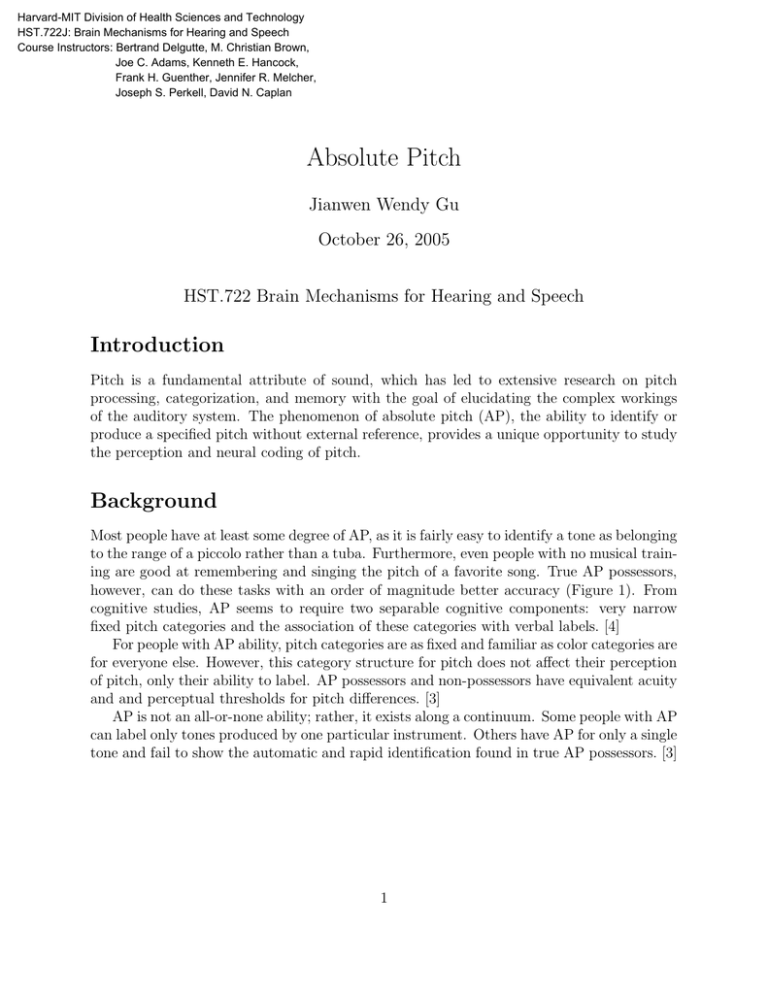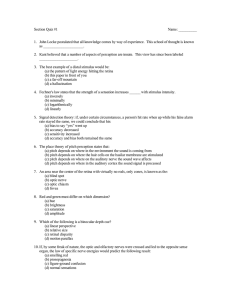Document 13574224
advertisement

Harvard-MIT Division of Health Sciences and Technology HST.722J: Brain Mechanisms for Hearing and Speech Course Instructors: Bertrand Delgutte, M. Christian Brown, Joe C. Adams, Kenneth E. Hancock, Frank H. Guenther, Jennifer R. Melcher, Joseph S. Perkell, David N. Caplan Absolute Pitch Jianwen Wendy Gu October 26, 2005 HST.722 Brain Mechanisms for Hearing and Speech Introduction Pitch is a fundamental attribute of sound, which has led to extensive research on pitch processing, categorization, and memory with the goal of elucidating the complex workings of the auditory system. The phenomenon of absolute pitch (AP), the ability to identify or produce a specified pitch without external reference, provides a unique opportunity to study the perception and neural coding of pitch. Background Most people have at least some degree of AP, as it is fairly easy to identify a tone as belonging to the range of a piccolo rather than a tuba. Furthermore, even people with no musical train­ ing are good at remembering and singing the pitch of a favorite song. True AP possessors, however, can do these tasks with an order of magnitude better accuracy (Figure 1). From cognitive studies, AP seems to require two separable cognitive components: very narrow fixed pitch categories and the association of these categories with verbal labels. [4] For people with AP ability, pitch categories are as fixed and familiar as color categories are for everyone else. However, this category structure for pitch does not affect their perception of pitch, only their ability to label. AP possessors and non-possessors have equivalent acuity and and perceptual thresholds for pitch differences. [3] AP is not an all-or-none ability; rather, it exists along a continuum. Some people with AP can label only tones produced by one particular instrument. Others have AP for only a single tone and fail to show the automatic and rapid identification found in true AP possessors. [3] 1 Figure removed due to copyright considerations. Figure 1: Distributions of pitch-name responses to randomly presented tones, plotted as distance from correct response. Key Issues AP Acquisition Musical training is essential for AP to manifest itself and most importantly, this training must happen early in life (Figure 2), which supports the hypothesis of a critical period during which AP can be acquired [3]. The type of training does have some influence, for Figure removed due to copyright considerations. Figure 2: Data from retrospective reports on age of acquisition of AP, as modeled by a Gamma function. much musical training involves teaching of relative pitch, but it cannot account for all of 2 the variance in the population. In fact, AP ability often develops without explicit tutoring: mere exposure to tones and their labels can be sufficient. [4] A fundamental question regarding AP acquisition remains to be answered: which neu­ ral events are responsible for this fairly fixed developmental time course? There are many neurodevelopmental processes with critical periods, such as language acquisition and the columnar segregation of neurons in the visual cortex. Understanding the molecular mecha­ nisms that lead to AP acquisition could shed light on neural development in general. [4] AP and Genetics Since most people who receive musical training from a young age do not develop AP, early training can be only part of the story. Two recent findings point to a genetic component. First, there are significant associations between siblings who demonstrate AP even when environmental factors are controlled. Second, AP may be differentially distributed across different human populations. For example, people of Asian descent have a much greater incidence of AP than those of other backgrounds. Moreover, this higher rate of AP is found across several Asian ethnicities (Chinese, Korean, and Japanese) that are distinct from one another culturally and is unrelated to speaking tonal languages. Neither Korean nor Japanese is a tonal language, and the higher incidence has also been reported among Asian-Americans who speak only English. [4] Although these observations support the idea of a genetic component, it is difficult to control all environmental factors. More rigorous methods and larger samples must be utilized to identify genetic influences of AP with certainty. [4] Neural Correlates of AP The development of structural and functional imaging techniques have enabled researchers to probe the neural correlates of AP. Anatomically, regions of the right superior temporal cortex and planum temporale (PT) tend to be smaller in AP possessors than non-possessors. [3] Early studies using event-related potentials (ERPs) indicated that listeners with AP showed an absent or reduced electrical scalp component that is thought to index the updating of working memory. Listeners without AP had a physiological response to a certain pitch change, indicating that some type of online memory system had been refreshed. AP posses­ sors did not show this response presumably because their memory representations consist of fixed, absolute values for each pitch. Therefore, pitch representation requires encoding into working memory but no updating once it’s in memory. [4] A related phenomenon has been observed using measures of cerebral blood flow (CBF) as shown in Figure 3, specifically positron emission tomography (PET) and functional magnetic resonance imaging (fMRI). An area of the right frontal cortex believed to be important for monitoring pitch information in working memory was more active among musicians lacking AP than in those with AP. AP possessors apparently used their categorical representation of tones in such tasks instead of requiring continuous maintenance of a sensory trace. [4] 3 Figure removed due to copyright considerations. Figure 3: Data from a PET study of AP and relative (RP) possessors, who labeled (a) isolated tones and (b) intervals. Conversely, a different area of the frontal lobe, the posterior dorsolateral cortex, was more active in subjects with AP than in control musicians, when listening to tones. This area is known to be involved in establishing and maintaining conditional associations in memory. Thus, it is a logical candidate region for the link between a pitch and its label in AP possessors. Additional support for this idea comes from the finding that the same area is active in both subjects with AP and those without AP when asked to label pairs of tones that form musical intervals. [4] These findings show that working memory and associative learning aspects of AP draw on neural resources that are reasonably well understood. However, this still does not explain the component of AP related to fixed pitch categories. Part of the answer to this issue may lie in the function of subcortical nuclei important for periodicity coding and coincidence detection, such as the inferior colliculus, which could provide input based on intrinsic oscillations to the auditory cortex of AP possessors. [4] 4 Topic Papers People with absolute pitch process tones without producing a P300 Klein et al. measured the P300 in seven AP possessors and seven non-possessors in response to auditory and visual stimuli. The P300 is a positive-going component of the ERP, which is believed to be a manifestation of the processes of maintaining or updating working memory. It is obtained in the “oddball” procedure in which two discrete stimuli (one frequent and one rare) are presented in a Bernoulli sequence; the subject counts the rare stimulus, which elicits a large P300. The control subjects showed standard ERPs in both visual and auditory modalities. AP subjects, however, showed a small P300 for the rare auditory stimulus but a normal P300 for the rare visual stimulus. These results suggest that AP possessors have access to permanent representations of the tones so they do not need to utilize working memory to fetch and compare representations for novel stimuli. [2] Functional anatomy of musical processing in listeners with absolute pitch and relative pitch Zatorre et al. used structural and functional brain imaging techniques to investigate the neural basis of AP. Twenty right-handed musically trained volunteers were included in the study: 10 AP possessors and 10 subjects with good relative pitch (RP) but no AP. PET was used to measure CBF during the presentation of musical tones to the subjects. Similar patterns of increased CBF were seen in auditory cortical areas in both groups. The AP group also demonstrated activation of the left posterior frontal cortex, an area thought to be related to learning conditional associations. This activity was also observed in nonAP subjects when they made relative pitch judgments of intervals. Activity within the right inferior frontal cortex was observed in RP but not in AP subjects during the interval judgment task, suggesting that AP possessors need not access working memory mechanisms in this task. MRI measures of cortical volume indicated a larger left PT in the AP group. [5] Absolute pitch and planum temporale In this study by Keenan et al., anatomical MRI was used to measure PT size of a right-handed group of 27 AP musicians, 27 nonmusicians, and 22 non-AP musicians. The authors hoped to settle the debate over whether the increased leftward asymmetry seen in AP possessors was due to an increase in the left PT, a decrease in the right PT, or a redistribution and reallocation of resources between the two hemispheres. The AP musicians showed greater leftward asymmetry and smaller right absolute PT size compared to the other two groups. The increased PT asymmetry of AP musicians was not seen in the group of early beginning non-AP musicians, suggesting that this asymmetry might be genetically based. [1] 5 Conclusion In summary, AP is an ability that involves both higher and lower levels of auditory processing. Its manifestation is influenced by the interaction of genes and environment. Thus, it is a neatly packaged phenomenon for studying many aspects of brain function. References [1] Julian Paul Keenan, Ven Thangaraj, Andrea R. Halpern, and Gottfried Schlaug. Abso­ lute pitch and planum temporale. NeuroImage, 14:1402–1408, 2001. [2] Mark Klein, Michael G. H. Coles, and Emanuel Donchin. People with absolute pitch process tones without producing a P300. Science, 223(4642):1306–1309, March 1984. [3] Daniel J. Levitin and Susan E. Rogers. Absolute pitch: Perception, coding, and contro­ versies. Trends in Cognitive Sciences, 9(1):26–33, January 2005. [4] Robert J. Zatorre. Absolute pitch: A model for understanding the influence of genes and development on neural and cognitive function. Nature Neuroscience, 6(7):692–695, July 2003. [5] Robert J. Zatorre, David W. Perry, Christine A. Beckett, Christopher F. Westbury, and Alan C. Evans. Functional anatomy of musical processing in listeners with absolute pitch and relative pitch. Proc. Natl. Acad. Sci. USA, 95:3172–3177, March 1998. 6



